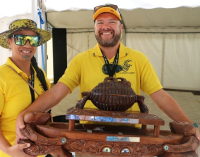
The world’s most prestigious kapa haka festival, Te Matatini, is underway at Ngā Ana Wai/Eden Park. Considered the Olympics of kapa haka, the brackets for each of the 45 rōpū are carefully planned according to strict rules.
Each section has four kaiwhiriwhiri (judges) who will judge the best group for those disciplines. Of the four marks given by judges for each discipline, the highest and lowest marks are removed, and the two middle marks are averaged to reach a total mark.
From the first action or utterance, each group have 25 minutes to perform their bracket including the seven compulsory disciplines:
Optional discipline: Waiata Tira
To settle nerves and warm up, groups may perform a choral-like piece which doesn’t qualify for points. Waiata tira can be sung acapella or with a guitar accompaniment, with a special emphasis on a harmonious blend of voices.
Discipline 1: Whakaeke
To whakaeke is to make an entrance. It can consist of waiata, haka, karanga and use of traditional weaponry and instruments. Because it isn’t limited to any genre, it is often the most innovative item. It acts like a pōwhiri as kapa will introduce who they are and their connection to the host people through pakiwaitara (folklore) and whakapapa (genealogy).
Discipline 2: Mōteatea
As centuries-old traditions of chanted song-poetry, mōteatea are a window to the past, to how tūpuna saw the world, how they felt, and what they knew. There is no harmony or choreography, but performers often emphasise the meaning and personal interpretation of the words through pūkana and other facial expressions, vocal emphasis and rhythm.
Discipline 3: Waiata-ā-ringa
Waiata-ā-ringa or action songs are a fairly contemporary addition to kapa haka, becoming popular from World War I. Modern waiata-ā-ringa were not an integral part of kapa haka until the 1930s, but are now an essential part of Māori performance.
Discipline 4: Poi
Poi are small balls at the end of string swung by women, even though they were traditionally used by tāne to train the suppleness of their wrists before battle. The poi represent environmental elements like water, birds and insects.
Perhaps one of the most recognizable parts of Māori culture is the haka. Haka is often used to highlight political or social issues facing te ao Māori and challenge the status quo.
Discipline 6: Whakawātea
This is the final chance for each rōpū to make a lasting impression, reiterate who they are and express their appreciation to the hosts before exiting the stage.
Discipline 7: Te Kairangi o Te Mita o Te Reo
While not a specific section of the kapa haka performance, groups are assessed on their reo Māori excellence.
How the competition works:
The competition has been split into three pools: Te Ihu, Te Haumi and Te Kei.
The four teams with the highest combined marks in the compulsory disciplines from each pool will compete in Te Matangirau, the finals, on the last day of the festival.
These 12 finalists will be judged afresh on the compulsory disciplines to determine Te Toa Whakaihuwaka – the overall aggregate winner. A winner will also be judged for each of the seven compulsory disciplines.
Rōpū are also judged throughout to win awards for best waiata tira, manukura tāne and wahine (male and female leader), kākahu (costumes), and best original compositions for poi, haka, waiata-ā-ringa, mōteatea and waiata.
NZ On Air: TE MATATINI SOCIETY INCORPORATED/SUPPLIED
An item might take you to a different web page. Return to the page with your back-arrow.